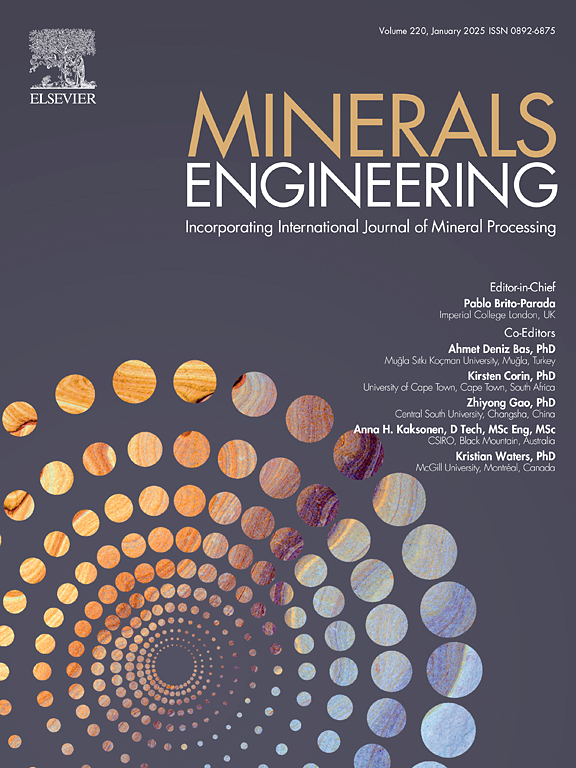浮选介质的离子强度及其影响
IF 4.9
2区 工程技术
Q1 ENGINEERING, CHEMICAL
引用次数: 0
摘要
环境因素和水资源短缺导致矿物加工厂需要循环使用更多的水。循环用水或使用海水等替代水源进行浮选会导致离子浓度增加和水质下降。水的再循环和水质的降低会增加离子强度,从而导致腐蚀、结垢、泡沫相的水回收率发生变化、矿物表面的物种沉淀导致意外活化或钝化、颗粒团聚(双层压缩)、浮选选择性丧失--品位和回收率降低、泡沫持久性以及气泡与颗粒之间的相互影响。不过,在某些情况下,离子强度的影响并不是影响浮选的主要因素;试剂类型和用量的影响可能更大。离子种类、温度及其相互作用会对浮选产生重大影响。某些离子种类,如硫酸盐、钠、钙、贱金属、氯和硫代硫酸盐,都有阈值浓度。如果超过这些浓度,浮选就会受到负面影响。本文从对颗粒衰变长度(双层压缩)、浮选特性、阈值浓度、水膜失稳、浮选阶段的水回收、气泡特性、表面化学(沉淀物的形成和颗粒上的附着力)和冶金学的影响等方面讨论了水中溶解物种和离子强度的溶液化学性质。本文还介绍了离子强度、温度、溶液中的物种及其相互作用对矿物浮选的影响,以及水质变化的来源。这篇综述将作为进一步研究水质影响的基础知识。文章还讨论了研究差距和挑战。本文章由计算机程序翻译,如有差异,请以英文原文为准。
Ionic strength of flotation medium and consequential effects
Environmental factors and water scarcity have led to the recirculation of greater quantities of water in mineral processing plants. Recycling water or using alternate water sources, e.g. seawater, for flotation can result in an increase in ionic concentrations and lower water quality. Water recirculation and lower water quality can increase ionic strength which can cause corrosion, scale formation, changes in water recovery to the froth phase, precipitation of species on the mineral surfaces causing accidental activation or passivation, agglomeration of particles (double layer compression), loss in selectivity in flotation-lower grade and recovery, froth persistence, and impact bubble-particle interaction. However, in certain cases the effect of ionic strength is not the main factor affecting flotation; reagent type and dosage can have a more significant impact. The ionic species, temperature and their interactions can affect flotation significantly. Certain ionic species like sulfate, sodium, calcium, base metals, chlorine and thiosulphates have threshold concentrations. If these concentration are exceeded, flotation would be negatively effected. The solution chemistry of dissolved species and ionic strength in water is discussed in terms of effects on decay length (double layer compression) on particles, froth properties, threshold concentrations, water film destabilisation, water recovery to froth phase, bubble properties, surface chemistry (precipitates formation and adhesion on particles) and metallurgy. The effects of ionic strength, temperature, species in solution and their interactions on mineral flotation, and sources of variation in water quality are also presented in this article. This review will serve as fundamental knowledge for further study on the effects of water quality. Research gaps and challenges are also discussed.
求助全文
通过发布文献求助,成功后即可免费获取论文全文。
去求助
来源期刊

Minerals Engineering
工程技术-工程:化工
CiteScore
8.70
自引率
18.80%
发文量
519
审稿时长
81 days
期刊介绍:
The purpose of the journal is to provide for the rapid publication of topical papers featuring the latest developments in the allied fields of mineral processing and extractive metallurgy. Its wide ranging coverage of research and practical (operating) topics includes physical separation methods, such as comminution, flotation concentration and dewatering, chemical methods such as bio-, hydro-, and electro-metallurgy, analytical techniques, process control, simulation and instrumentation, and mineralogical aspects of processing. Environmental issues, particularly those pertaining to sustainable development, will also be strongly covered.
 求助内容:
求助内容: 应助结果提醒方式:
应助结果提醒方式:


